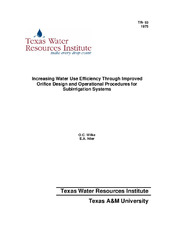| dc.creator | Wilke, O. C. | |
| dc.creator | Hiler, E. A. | |
| dc.date.accessioned | 2011-07-01T18:54:21Z | |
| dc.date.available | 2011-07-01T18:54:21Z | |
| dc.date.issued | 1975-02 | |
| dc.identifier.uri | https://hdl.handle.net/1969.1/94907 | |
| dc.description.abstract | Two mathematical models describing one-dimensional flow from buried sources and in unsaturated soils were developed. One considered the consumption of water by roots. For the assumed distribution of the root consumption with time and depth, the 10cm (4-in.) deep source provided better water distribution than did 20- and 30-cm (8- and 12-in.) deep sources. Irrigation from zero depth, as in the case of trickle irrigation, appeared to be the best system for the given conditions.
Plugging of emitters by particulate materials decreased as the cross-sectional area of the emitter opening was increased. Less than 0.06 atm (1 psig) vacuum had little effect on the flow of emitters tested. Higher vacuum amounts caused the reopening of plugged orifice emitters, but caused plugging of labyrinth emitters. Vacuum-induced plugging of labyrinth emitters resulted from accumulation of silt and fine sand within the flow path. Operation at higher pressures caused limited flow recovery.
A theory was proposed for determining pressure distributions in drip laterals where water is uniformly distributed along the lateral's length. The theory provided acceptable design in two tests. Computer-derived design curves were developed. Because 1000 or more emitters may be required for subirrigation of eachacre, emitters need to be both inexpensive and resistant to plugging. Four experimental emitters were designed and constructed. A modification of one microtube emitter is being produced commercially.
Two moveable drip systems were proposed. Drip irrigation lines successfully trailed a center-pivot irrigation system. Also a tractor-mounted implement was developed for moving individual drip irrigation laterals. | en |
| dc.language.iso | en_US | |
| dc.publisher | Texas Water Resources Institute | |
| dc.relation.ispartofseries | TR;63 | |
| dc.title | Increasing Water Use Efficiency Through Improved Orifice Design and Operational Procedures for Subirrigation Systems | en |
| dc.type | Technical Report | en |


